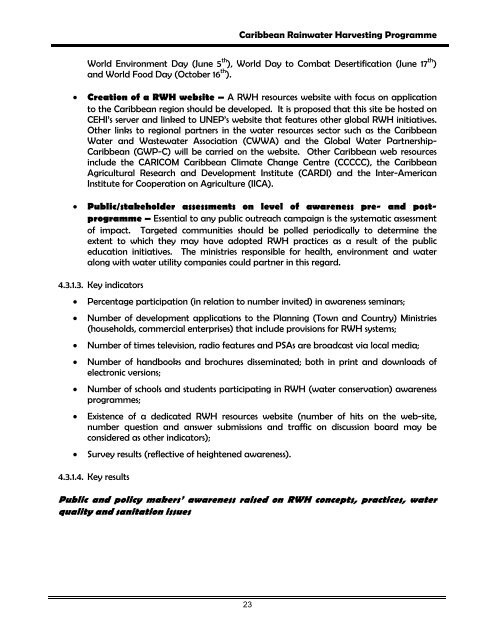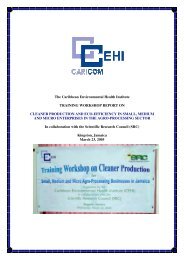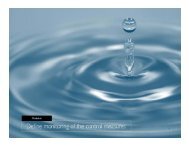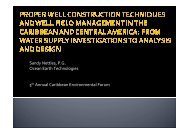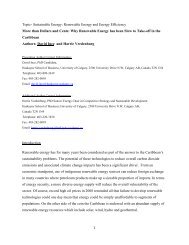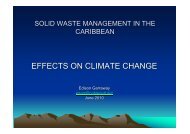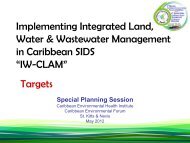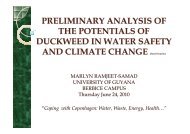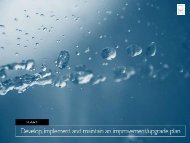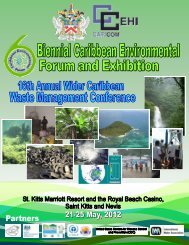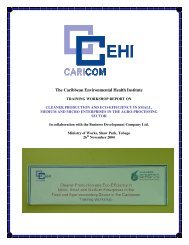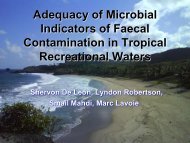A programme for Promoting Rainwater Harvesting in the Caribbean
A programme for Promoting Rainwater Harvesting in the Caribbean
A programme for Promoting Rainwater Harvesting in the Caribbean
Create successful ePaper yourself
Turn your PDF publications into a flip-book with our unique Google optimized e-Paper software.
<strong>Caribbean</strong> <strong>Ra<strong>in</strong>water</strong> <strong>Harvest<strong>in</strong>g</strong> ProgrammeWorld Environment Day (June 5 th ), World Day to Combat Desertification (June 17 th )and World Food Day (October 16 th ).• Creation of a RWH website – A RWH resources website with focus on applicationto <strong>the</strong> <strong>Caribbean</strong> region should be developed. It is proposed that this site be hosted onCEHI’s server and l<strong>in</strong>ked to UNEP’s website that features o<strong>the</strong>r global RWH <strong>in</strong>itiatives.O<strong>the</strong>r l<strong>in</strong>ks to regional partners <strong>in</strong> <strong>the</strong> water resources sector such as <strong>the</strong> <strong>Caribbean</strong>Water and Wastewater Association (CWWA) and <strong>the</strong> Global Water Partnership-<strong>Caribbean</strong> (GWP-C) will be carried on <strong>the</strong> website. O<strong>the</strong>r <strong>Caribbean</strong> web resources<strong>in</strong>clude <strong>the</strong> CARICOM <strong>Caribbean</strong> Climate Change Centre (CCCCC), <strong>the</strong> <strong>Caribbean</strong>Agricultural Research and Development Institute (CARDI) and <strong>the</strong> Inter-AmericanInstitute <strong>for</strong> Cooperation on Agriculture (IICA).• Public/stakeholder assessments on level of awareness pre- and post<strong>programme</strong>– Essential to any public outreach campaign is <strong>the</strong> systematic assessmentof impact. Targeted communities should be polled periodically to determ<strong>in</strong>e <strong>the</strong>extent to which <strong>the</strong>y may have adopted RWH practices as a result of <strong>the</strong> publiceducation <strong>in</strong>itiatives. The m<strong>in</strong>istries responsible <strong>for</strong> health, environment and wateralong with water utility companies could partner <strong>in</strong> this regard.4.3.1.3. Key <strong>in</strong>dicators• Percentage participation (<strong>in</strong> relation to number <strong>in</strong>vited) <strong>in</strong> awareness sem<strong>in</strong>ars;• Number of development applications to <strong>the</strong> Plann<strong>in</strong>g (Town and Country) M<strong>in</strong>istries(households, commercial enterprises) that <strong>in</strong>clude provisions <strong>for</strong> RWH systems;• Number of times television, radio features and PSAs are broadcast via local media;• Number of handbooks and brochures dissem<strong>in</strong>ated; both <strong>in</strong> pr<strong>in</strong>t and downloads ofelectronic versions;• Number of schools and students participat<strong>in</strong>g <strong>in</strong> RWH (water conservation) awareness<strong>programme</strong>s;• Existence of a dedicated RWH resources website (number of hits on <strong>the</strong> web-site,number question and answer submissions and traffic on discussion board may beconsidered as o<strong>the</strong>r <strong>in</strong>dicators);• Survey results (reflective of heightened awareness).4.3.1.4. Key resultsPublic and policy makers’ awareness raised on RWH concepts, practices, waterquality and sanitation issues23


